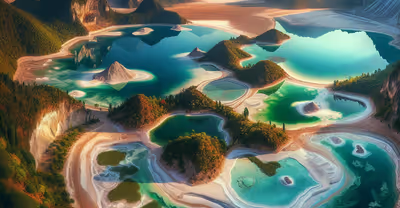
Key Takeaways
- Saltwater lakes provide unique ecosystems and scenic beauty.
- These lakes support specialized wildlife and plant life.
- Understanding these lakes offers insights into ecological diversity.
Ever wondered what makes a lake truly unusual?
It could be the story it tells through its unique characteristics like a rare salt concentration, creating a palette of awe for those who gaze upon its waters.
Lakes with naturally occurring saltwater are ecological marvels, home to a host of specialized life forms and stunning visual phenomena.
The lakes mentioned in our article are more than just large ponds.
They represent nature's ability to adapt and create environments that are as unique as they are beautiful.
From vast saline expanses that reflect the sky to hidden pools with mineral-rich waters, these natural wonders are a testament to the diversity of Earth's landscapes.
Their stories invite you to explore the many ways water can manifest in our world, often in the most unexpected places.
Great Salt Lake, Utah
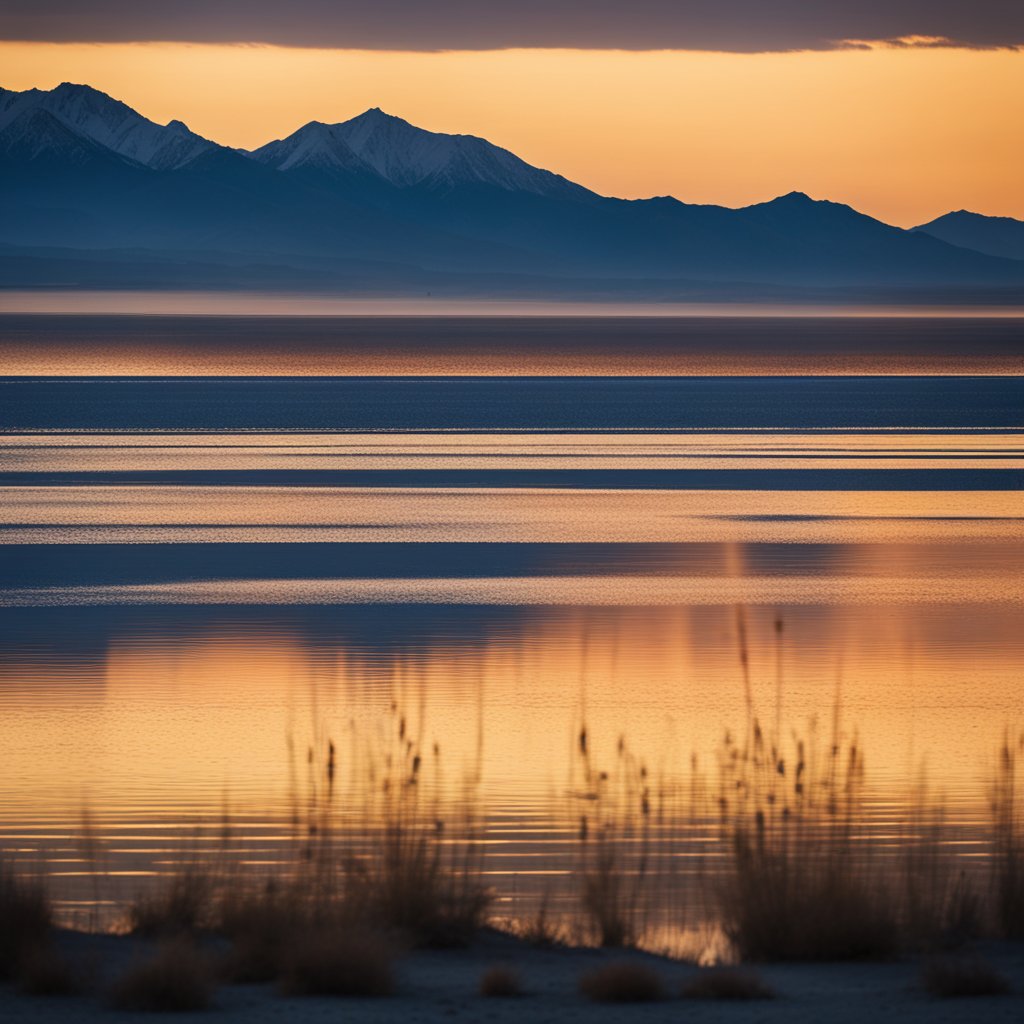
Ever waded into a lake so salty that you floated effortlessly?
The Great Salt Lake in Utah could be your next adventure!
Sprawling over 1,700 square miles, it's like a salty sea within the States.
What makes it tick?
It's a whopping leftover from Lake Bonneville, a colossal prehistoric lake!
Are you a fan of quirky facts?
Here's one: with a high salt content, the lake doesn't support your average lake wildlife.
Expect to see brine shrimp and algae, but not much else in the way of fishy friends.
Curious about depth?
Although it can get deeper in parts, the average depth hovers around 20 feet.
Pretty shallow for such a large body of water, don't you think?
What's there to do?
Oh, plenty!
Here are your options:
- Sailing and Kayaking: Breeze across the lake with full-service marinas at Antelope Island and the Great Salt Lake Marina as your starting points.
- Exploration: Set foot on Antelope Island for some amazing hiking and wildlife spotting.
And have you heard about the mysterious white mounds?
These strange formations are just one of the lake's oddities that continue to intrigue visitors and scientists alike.
So, when you're itching for a day by the water that's out of the ordinary, why not head to Utah's own salty wonder?
You're in for a unique experience that's truly one-of-a-kind.
Just remember, it's not your typical lakeside picnic, so plan for the salt!
Remember, embrace the unusual, because the Great Salt Lake is anything but mainstream!
Mono Lake, California
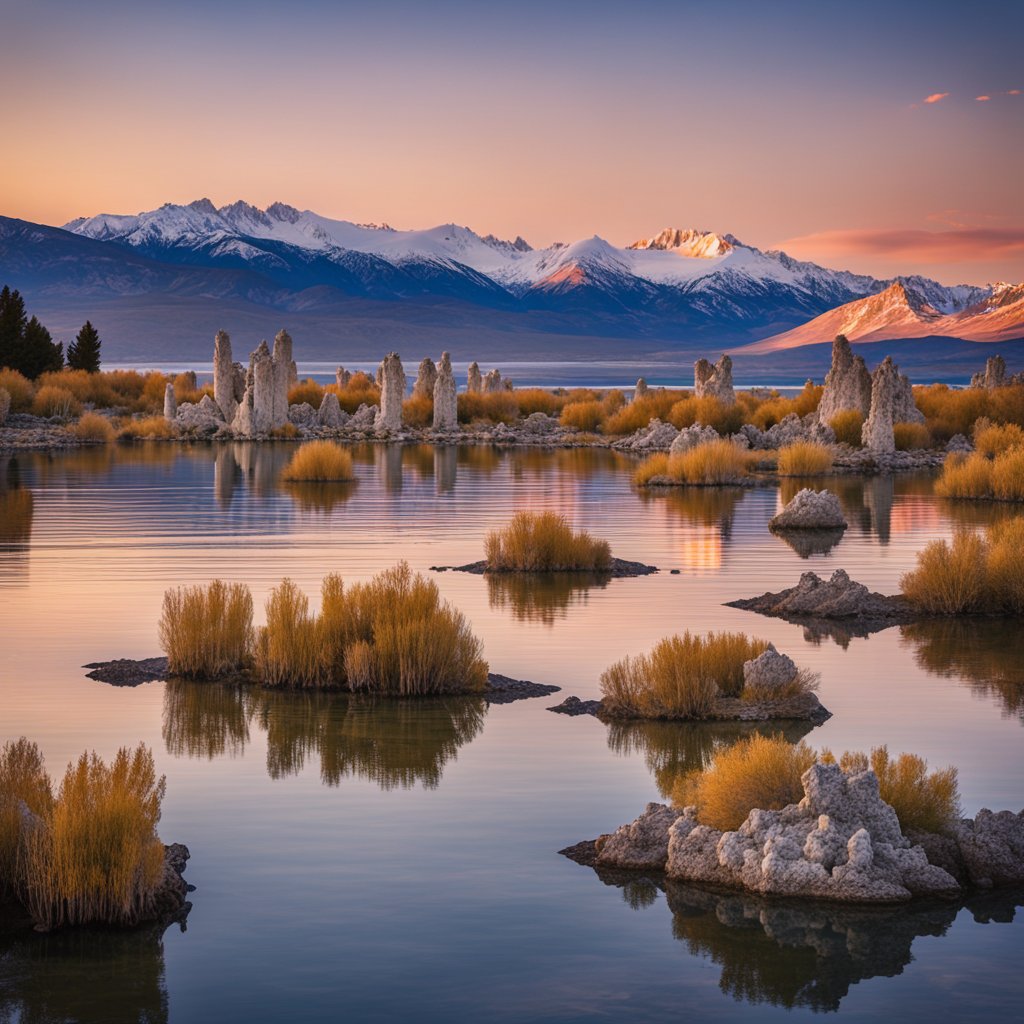
Have you ever heard of a lake so salty that it could rival the ocean?
Well, you’re in luck because Mono Lake in California is exactly that—a marvel of nature with water that's both salty and alkaline.
But what’s got people talking about this lake isn't just its salinity; it's also the otherworldly limestone spires known as tufa towers that jut out from its surface.
Impressive, right?
Here's a quick snapshot:
- Location: Mono County, California
- Formation: At least 760,000 years old
- Type: Saline soda lake
- Size: About 44,479 acres
- Depth: Average of 56 feet, deepest point at 160 feet
This isn't any old saltwater lake - Mono Lake has no outlet, causing salts to pile up and create a unique alkaline habitat.
Let me break it down for you:
- Alkalinity: Lake water that could give baking soda a run for its money.
- Life: Brine shrimp thrive here, despite the salt. They attract lots of birds, too.
And don't think the lake's just floating in the middle of nowhere.
It's cozily nestled in Mono Basin National Forest Scenic Area, just next to Yosemite National Park.
It's the kind of place that makes you ask, "How does nature even do that?"
Thinking about dipping your toes?
Well, it might be more of a float, given the saltiness.
But those tufa towers are best admired from a distance—no climbing, please!
They're fragile works of natural art, sculpted by chemistry and time.
Did You Know?
Mono Lake is one of California's oldest lakes and covers more than 70 square miles.
Quite the senior citizen, wouldn't you say?
Whether you're a nature enthusiast or just someone who appreciates the quirks of our planet, Mono Lake is a sight to behold and a testament to Earth's knack for surprises.
Salton Sea, California
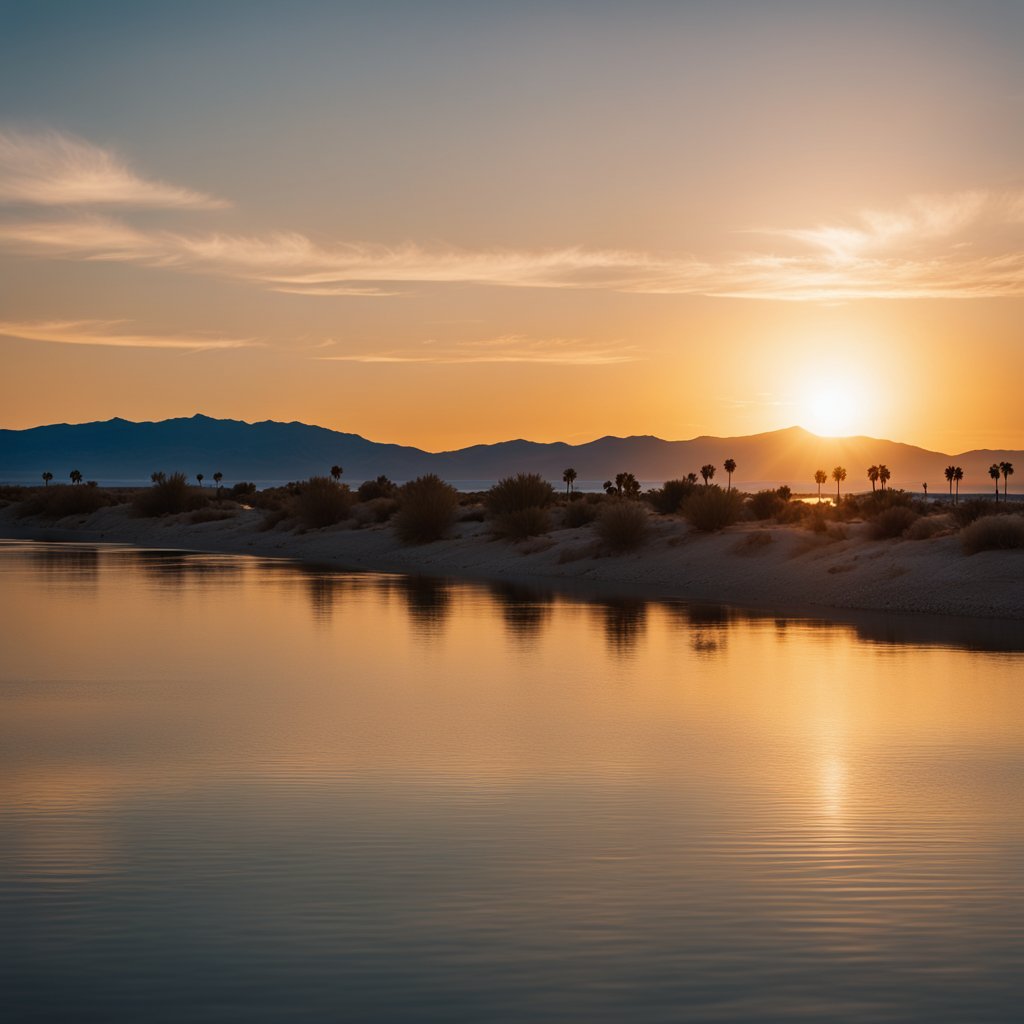
Have you ever heard of a lake in the desert?
Yes, that’s the Salton Sea for you!
Nestled in Southern California, the Salton Sea is a bit of an oddball in the world of lakes.
Back in 1905, a flood caused the Colorado River to spill over into a dry lakebed, which led to the birth of this expansive body of water.
But don’t let its origins fool you; it's no ordinary lake!
- Salinity: With an annual inflow of roughly four million tons of salt from irrigation water, the Salton Sea’s water is anything but sweet.
- Size: As California's largest lake, this place once attracted celebrities looking for a picturesque getaway spot, but the landscape has changed quite a bit.
Here’s a quirky fact: Despite its high salinity and environmental challenges, the Salton Sea remains a critical stopping point for migratory birds.
It's like nature's very own airport layover spot in the middle of a desert!
Although not as salty as the Dead Sea, its salinity is on the rise due to evaporation and agricultural runoffs.
This might make you wonder about the future of this unusual lake.
Will it be a salty wonder or a desolate spot?
Whatever it becomes, the story of the Salton Sea, California sure is one for the books!
Devils Lake, North Dakota
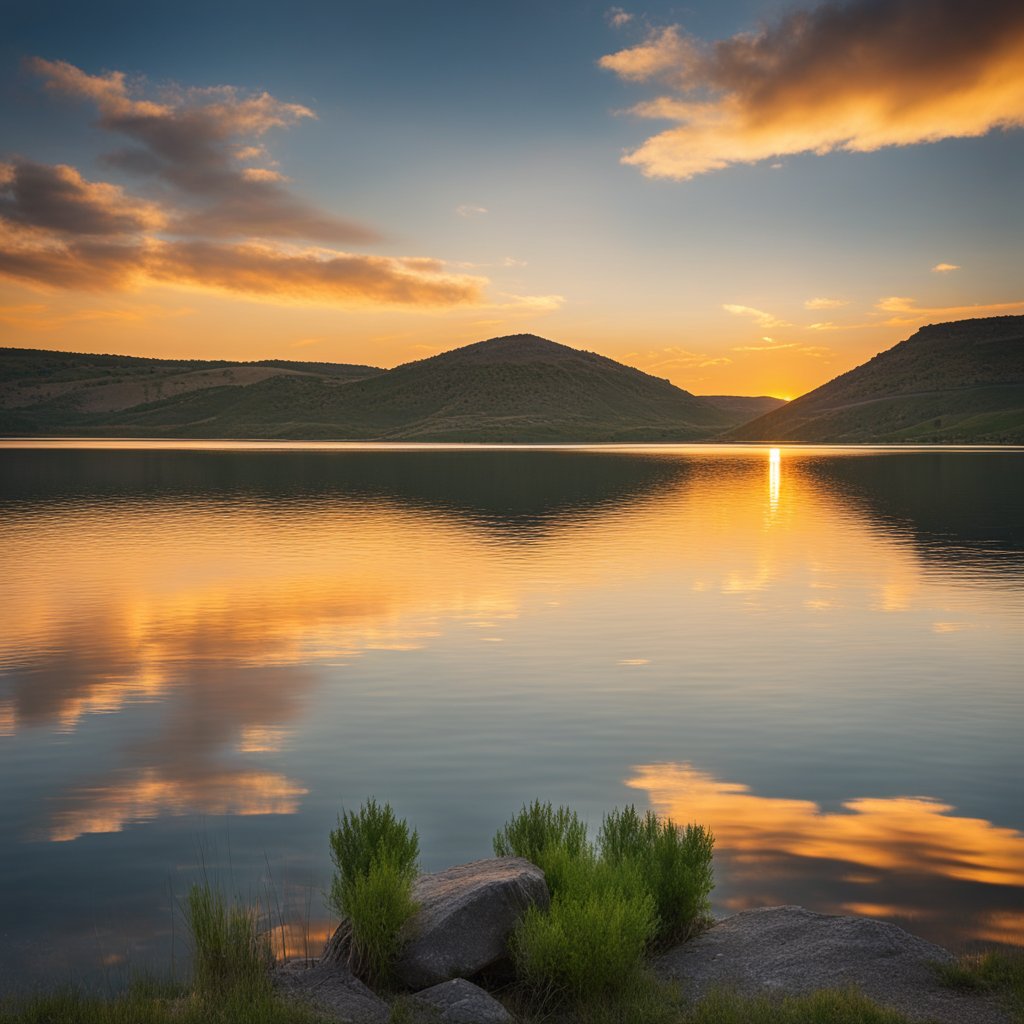
Have you ever heard of a lake that keeps on growing but has nowhere to go?
Meet Devils Lake in North Dakota, an unusual and captivating body of water with a bit of an identity crisis.
Size and Location:
- Area: Over 190,000 acres
- Location: Nestled within Ramsey and Benson Counties
Water Levels:
- Historical High (2011): 1,454.3 feet
- Natural Overflow Elevation: 1,458 feet
- Flow: Into Sheyenne River via Tolna Coulee
While many lakes can boast about their natural beauty, Devils Lake stands out for an extraordinary reason—it's an endorheic basin.
This means the lake doesn't have a natural outlet to the ocean.
As it expands, the water gets saltier, since the only way for water to leave is through evaporation, leaving minerals behind.
Curious about its impact?
In 2011, the lake hit near-record water levels, leaving many local fields submerged under its expanding shores.
Think of the frustration when 130,800 agricultural acres go underwater!
Why It Matters: What happens when farmland turns into a lakebed?
Aside from new waterfront properties, there was a direct loss of $36.2 million in agricultural production back in 2016.
Now, you might ask, "Is it really saltier?" Absolutely!
The expanding boundaries of Devils Lake mean that the concentration of salts increases.
So, if you ever find yourself at the largest natural lake in North Dakota, remember, you're experiencing a unique natural phenomenon!
Enjoy the view and the conversation starter it offers—just don’t forget to watch your step.
It’s not every day you see a lake on the move!
Salt Lake, Minnesota
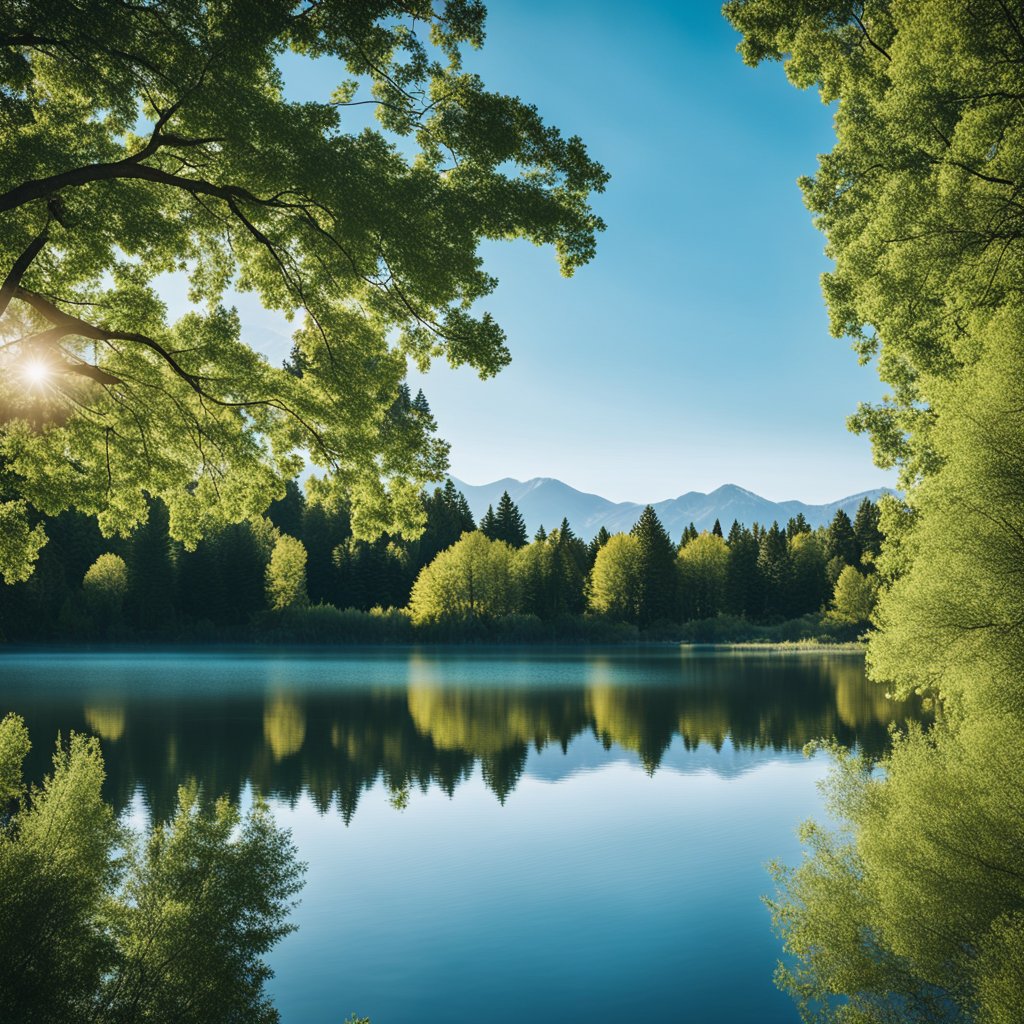
Have you ever heard of a salty lake in the heart of the Midwest?
Yep, that's right, Salt Lake in Minnesota is a bit of a geographical oddity – it's naturally salty!
Tucked between Minnesota and South Dakota, this 312-acre gem is a natural lake with a salinity punch.
Interestingly, Salt Lake is roughly one-third as salty as the ocean.
This level of salinity is a result of the alkaline soils in the area.
It's quite the standout – being the only alkaline lake in Minnesota.
But what does this mean for the local ecosystem?
Fascinating things, actually!
- Bird Haven: Brine-loving birds flock here, making it an avian paradise.
- Salt Lake Wildlife Management Area: This protective designation keeps the lake and its unique environment secure.
Ever seen birds that thrive on brine?
Grab your binoculars because here's a list of what you might spot:
- Shorebirds
- Waterfowl
- Unique plant species
Now, let's talk location:
- Where? Southwestern Minnesota, right on the border with South Dakota.
- Viewing Platform? Yes! For all you bird watchers, there's a spot just for you.
Over the years, bird counts have turned into a tradition for enthusiasts, ringing in the spring with sightings and sounds.
So, why not take a little road trip there?
A hint for travelers: Grab your best camera because this salty spectacle is not just a lake—it's a story, a sanctuary, and a surprise, all beautifully mingled into the Midwestern prairies' tapestry.
Ready for a quirky nature nugget in your next adventure?
Keep Salt Lake, Minnesota, on your radar.
Soap Lake, Washington

Have you ever bathed in water that felt just a little silkier than usual?
Imagine an entire lake with such water.
Welcome to Soap Lake, located in the delightful state of Washington.
This isn't your average lake; it's a mineral haven with a quirky twist that'll leave you feeling both fascinated and refreshed.
Why is it so special?
- Mineral content: You might be using mineral-enriched products for your skin, but Soap Lake is nature's own spa. The lake has a mineral concentration higher than any other—we're talking a whopping 23 different minerals!
- Medicinal properties: The locals aren't just boasting when they say Soap Lake has healing powers. With its unique mineral cocktail, many believe it can relieve conditions like skin disorders.
- Buoyancy: Feel like floating without a floatie? Soap Lake's high mineral density makes you buoyant. Talk about a natural swim assistant!
Let's get soapy!
Ever wondered why it's called 'Soap Lake'?
Don't worry, no one dropped a giant bar of soap in there.
The lake got its name from the naturally occurring foam—thanks to the mineral-rich waters—that gives it a slippery, soapy feel.
A little geography lesson for you: Soap Lake measures approximately 2 square miles and was formed by the Missoula Floods.
It's a reminder of the incredible forces of nature and how they shape our world.
Fun Facts:
- Location: Just a stone's throw from Moses Lake and about 20 miles north of I-90.
- History: It's packed with it! But now, it's the breathtaking natural landscape that steals the show, making civilization seem like just a "mere blip."
So, if you're up for a unique soak and perhaps a little history, Soap Lake is a must-visit.
Time to tick it off your bucket list, don't you think?
Lake Abert, Oregon
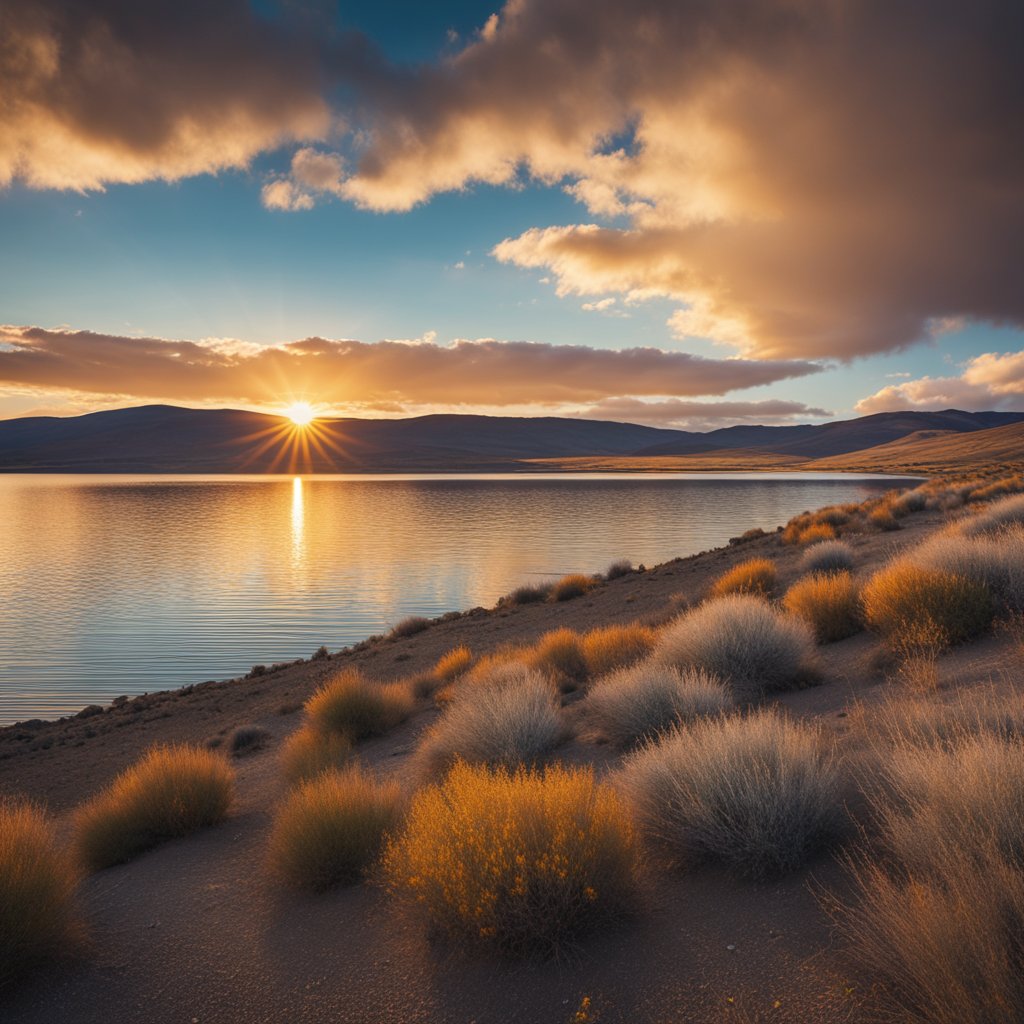
Have you ever wondered about lakes that are salty by nature?
Well, right in the southeastern corner of Oregon, sits a peculiar gem: Lake Abert.
You might not think of lakes as being salty, but Lake Abert defies that freshwater stereotype.
Here's a quick dive into what makes Lake Abert stand out:
Size Matters:
- Area: 65 square miles when full
- Depth: Averages a mere 5 feet
One of a Kind:
- Unique Trait: The only hypersaline lake in Oregon.
- Company: Only one of three such lakes in the entire U.S.
Birds Love It:
Bird enthusiasts, you're in for a treat!
This lake is not just a salty puddle.
It's a crucial stopover for migratory birds—they really use this spot to rest and fuel up.
Ecology Notes:
- Habitat: Provides for hundreds of thousands of migratory species.
- Salt Crust: A thick crust appears when water levels drop.
Changes to Note:
If you're into ecological drama, here's a tidbit—Lake Abert has seen some tough times, with parts drying up in 2014.
But don't worry, it's still a site to behold.
Alkaline Levels:
- pH: Alkaline nature, with high pH levels.
So, any plans to visit the high desert of Oregon?
If you do, remember to swing by Lake Abert.
It's not just any lake; it's an alkaline, hypersaline eco-haven.
Plus, who doesn't want to see a lake that has its own salt crust?
Pretty cool, right?
Walker Lake, Nevada
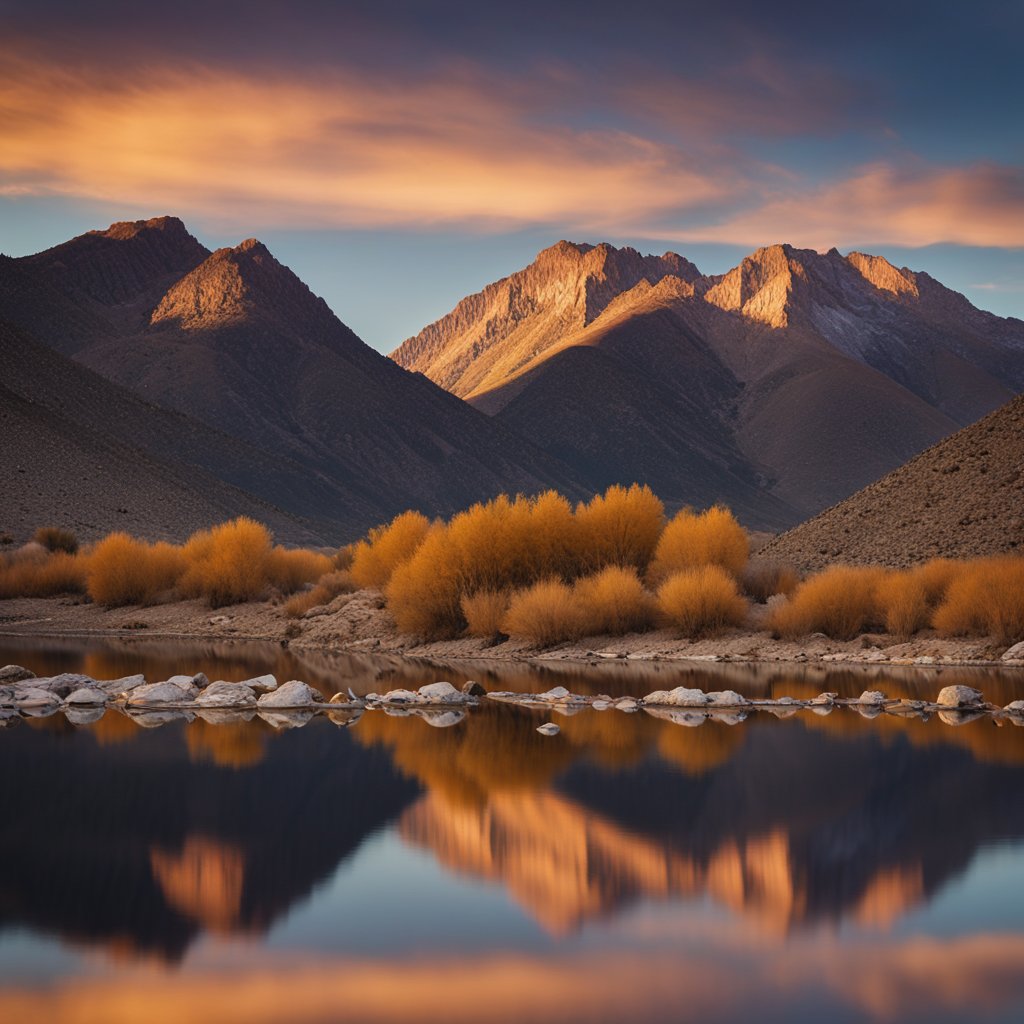
Have you ever wondered about lakes with a twist?
Let’s take a trip to Walker Lake in Nevada, a body of water as intriguing as it is salty.
Ever heard of Lake Lahontan?
Well, Walker Lake is one of the last remnants of this ancient marvel, dating back thousands of years.
Isn’t history fascinating?
Walker Lake is nestled within the rugged scenery of Nevada, bordered by the Wassuk Range.
With dimensions of about 11 miles long and 5 miles wide, it's like a desert gem with a story to tell.
Now, let’s talk salt.
This isn't just any regular lake; the salinity here has been marching upward—and that's due to one main culprit, water diversion reducing its volume.
- Location: Northwestern Mineral County, Nevada
- Size: Estimated 11 mi by 5 mi
- Origin: Remnant of Ancient Lake Lahontan
Wanna hear some figures that will make you raise an eyebrow?
Over time, Walker Lake's water level has been dwindling, causing a spike in its total dissolved solids.
That’s a fancy way of saying it's getting saltier by the day.
So, why should you care about Walker Lake's salt levels?
Here’s a simple reason: life in the lake depends on it.
Higher salinity can challenge the ecosystem and its aquatic inhabitants.
Imagine trying to swim in a pool of salt water day in and day out—it's rough on the locals!
Now, don't get gloomy on me.
Despite its plight, there's a glimmer of hope.
Efforts are underway to restore Walker Lake to its healthy, life-sustaining state.
Keep an eye on this spot; it might just become the "great restoration story of the West"!
Remember, whether you're a nature enthusiast or just plain curious, seeing Walker Lake with your own eyes can offer a poignant glimpse into the delicate balance of our natural world.
So why not add it to your must-visit list?
Just imagine the stories you'll have to tell!
Pyramid Lake, Nevada

Have you ever gazed upon a landscape that looks like it's straight out of a painting?
Well, that's Pyramid Lake for you!
This incredible body of water is nestled 40 miles northeast of Reno, in Nevada.
What's so unusual about it, you ask?
It's a hefty slice of history, being the largest remnant of the ancient Lake Lahontan that covered much of Nevada many, many years ago.
Size Matters
Pyramid Lake is nothing short of impressive.
With its vast expanse, it covers about 125,000 acres.
That's right, it's huge:
- Length: 27 miles
- Width: 11 miles
- Depth: 350 feet
- Surface Area: Approximately 188 square miles
A Sight to Behold
It isn't just the size; the lake's charm lies in its tranquility and the unusual rock formations that resemble, well, pyramids!
Wake up early to catch a sunrise, and you'll see why it's a beloved locale.
Recreation and More
Camping buffs, rejoice!
The Pyramid Lake Marina and RV Park offers spacious spots right on those serene shores.
Whether you're pitching a tent or rolling up in your RV, it is the perfect place to unwind.
Cultural Hub
This saltwater marvel is cradled within the Pyramid Lake Paiute Tribe Reservation, adding a rich cultural heritage to your visit.
Remember, it's not just any lake — it's Pyramid Lake, where the desert skyline meets a saltwater oasis, providing a perspective that's both humbling and awe-inspiring.
Next time you're in Nevada, why not swing by?
Big Soda Lake, Colorado

Have you ever found yourself longing for a unique beach day, perhaps with a twist of natural science?
Let me introduce you to Big Soda Lake in Colorado.
Tucked away in the soothing embrace of the Rocky Mountains, and just a stone's throw from the fame of Red Rocks Amphitheater, this lake is a gem for the Denver community.
Key Features:
- Location: Bear Creek Lake Park, short drive from downtown Denver
- Activities: Swimming, stand-up paddleboarding, kayaking, and windsurfing
- Accessibility: Ideal for families and beginners in water sports
Imagine dipping your toes in water that's got its own natural fizz!
That's right, the lake's higher salinity levels give it the quirky name 'Soda'.
But don't expect to taste the sweetness of soda pop; this is all about the lake's unique mineral composition.
Here's what you can enjoy at Big Soda Lake:
- A serene swim beach that's just right for kids
- Calm waters, perfect for your first paddleboard or kayak outing
- The rare opportunity to engage with an ecosystem different from the usual freshwater lakes
Did you know?
Despite its proximity to a bustling highway, peace and tranquility reign supreme once you're by the lakeside.
Pro tip: Make your visit between Memorial to Labor Day, when rentals like paddleboats and canoes are available for an even more enjoyable experience.
So grab your sunscreen, rally the family, and make a tiny detour off the beaten path to Big Soda Lake – because sometimes the most unusual spots turn out to be the biggest delights!


